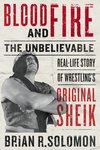


If you ever met Eddie Farhat (and I did), he came across as a mild-mannered family man. But when he entered the “squared circle” —the wrestling ring — he switched on his persona as the Sheik, one of professional wrestling’s truly bad guys. During his nearly 50-year career, which began after World War II, he brought blood, mayhem and ghastly entertainment to the sport as both a feared wrestler and a savvy promoter.
In his new book, “Blood and Fire: The Unbelievable Real-Life Story of Wrestling’s Original Sheik,” noted wrestling writer Brian R. Solomon tells the amazing story of one of wrestling’s original “heels,” which was the industry’s catchphrase for villains of the ring. Farhat, born in Lansing in 1926 and raised here, died at 77 in Williamston in 2003.
The Sheik’s feats in the ring came when wrestling transitioned from fraternal halls to the national stage via television. It added a whole new dynamic to wrestling. Most television stations, hungry for content, held weekly matches in their studios that might draw 30 to 40 people.
“They basically served as infomercials for upcoming matches, and since only one camera was used, the audience looked huge,” Solomon said, describing another trick of the trade.
Farhat began his career in Lansing in 1947 after returning from the service, where he wrestled on Army teams.
“He wrestled using his own name, but it wasn’t long before he transitioned to the Sheik, posing as an exotic oil baron from the Middle East despite being Catholic,” of Lebanese descent, Solomon said.
Solomon said Farhat was seldom out of character in his role as the Sheik. If phone callers who reached him at home asked for Eddie, Ed or Mr. Farhat, he hung up on them.
“He entered the ring in flowing robes, wearing pointy-toed boots and either a turban or later a keffiyeh, and he would lay down a prayer rug and pray to Allah,” he said.
Solomon details how as his “kayfabe” or his “shtick” developed, the Sheik would use flash paper which he lit with a flint hidden in his trunks to throw fiery orbs at his opponents. The Sheik perfected the art of cutting his forehead to bleed profusely during matches, and many photographs of him wrestling show a bloodied face and chest. He used the cutting technique so much that he developed obvious scar tissue on his forehead.
“He never broke kayfabe or the code of wrestling which protected a wrestler’s tricks,” Solomon said. The derivation of the word is nebulous, according to Solomon, but it is believed it was handed down from circus carneys who protected their routines from outsiders.
During his career, Farhat lived in Lansing and later Williamston on a grand estate, today a bed and breakfast. At one time, he also owned a restaurant in Williamston.
The wrestling business as we know it today, in the Vince McMahon era of arena wrestling, is quite different from the 1950s and ’60s, when a community could see numerous matches monthly at civic centers.
“In some ways, the regional wrestling model was more successful than the one or two major matches you see today,” Solomon said.
Solomon also showcases how wrestlers were best friends behind the scenes and out of the public eye of both villains and “babyfaces,” or good guys. This was especially the case with Farhat and babyfaced “Leaping” Larry Chene, who had some epic matches. While wrestling in Texas early in their careers, the Chene and Farhat families shared an apartment.
“Chene was absolutely the hottest big guy,” Solomon said.
In the 1960s, Farhat bought a Detroit promotional company, Big Time Wrestling, and had big plans to have himself and Chene become the centerpieces. But Chene died in an auto accident driving home from a match.
The book details how Farhat instead enlisted Bobo Brazil, a popular African American wrestler, to serve as his babyface. Despite wrestling scores of times against each other, the two became best friends.
Despite having a successful career as a wrestler and promoter, Farhat filed for bankruptcy twice and sold his beloved Williamston home, where he and his spouse, Eva, raised two boys.
“At the height of his career, Farhat declared income of $400,000,” Solomon said.
Solomon surmises that part of the problem was after the 1967 riot, people quit coming to downtown Detroit to watch events at Cobo and Olympia Stadium, adding to the demise of wrestling.
“Farhat probably put more people in seats at Cobo Hall than any of the other events that were held there,” he said.
Solomon, a certified teacher, has spent much of his career writing for various wrestling publications and WWE.
He said he began writing about wrestling for his high school and college newspaper and recalls his grandfather taking him to Madison Square Garden to watch wrestling when he was a teenager.
“He was a prize fighter and a coach, and I think he wanted me to see how fake it was. I became a fan,” he said.
In his book, Solomon uses a fantastic photograph to illustrate how big the Sheik and wrestling were at one time. The photo shows a marquee featuring the Sheik versus Dick the Bruiser, Elvis, Marvin Gaye and Evel Knievel.
“The Sheik and the Bruiser got top billing,’ Solomon said.
Support City Pulse - Donate Today!
Comments
No comments on this item Please log in to comment by clicking here